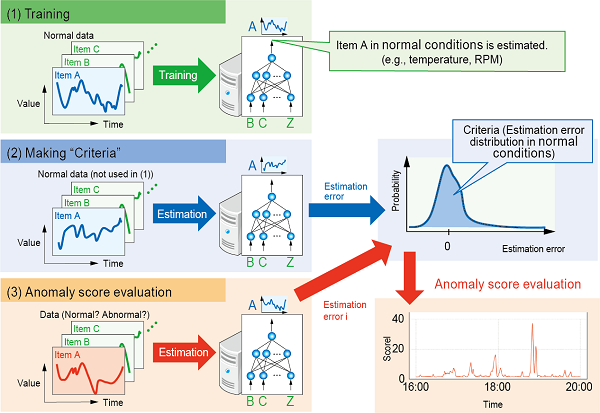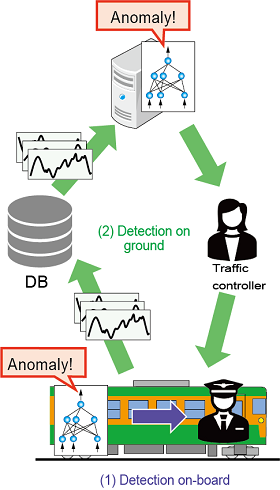14. Automatic anomaly detection using vehicle condition monitoring data without additional sensors
In recent years, more and more systems for recording and summarizing the operating conditions of vehicle equipment have been adopted, enabling the accumulation of large quantities of vehicle condition monitoring data.
This data can be used to promptly detect anomalies in vehicle equipment in operations without additional sensors, thereby improving the operational reliability further.
However, due to complex changes in vehicle equipment conditions, it can be difficult to detect anomalies using only simple criteria, such as “when a threshold value is exceeded.”
We therefore proposed a method for extracting the characteristics of vehicle equipment conditions from vehicle condition monitoring data using a neural networks-based machine learning technique to determine the degree of anomaly (anomaly score) of the vehicle equipment (Fig. 1).
(1) Firstly, a neural network is trained with vehicle condition monitoring data when vehicle equipment operates in normal conditions and a model is created to estimate item A, which expresses equipment conditions that would be affected by anomalies, from other items.
(2) Next, the model and data not used for training are utilized to obtain the frequency distribution of differences between the estimated values and the actual measured values (estimation error distribution) of item A in normal conditions.
(3) Finally, based on the estimation error of item A for the data in an actual operation and the estimation error distribution in normal conditions, the anomaly score—defined such that the lower the probability that the estimation error occurs, the higher its value—is calculated for each time period.
When we applied the proposed method to vehicle condition monitoring data acquired from operational vehicles, we verified that it is capable of promptly detecting anomalies, such as an engine overheating or a decline in air conditioning unit performance, based on increases in anomaly scores.
By applying the proposed method to a condition monitoring system as in Fig. 2, crew and traffic controller are able to promptly ascertain the occurrence of anomalies in vehicle equipment.
This enables them to take appropriate action, such as repairing the equipment before a serious breakdown occurs.
Other Contents
- 12. System for determining the degree of deterioration of wooden sleepers using images of railway tracks in front of trains
- 13. A method for constructing communication-based train control systems using public communication network
- 14. Automatic anomaly detection using vehicle condition monitoring data without additional sensors
- 15. An soundness evaluation index and method for dealing with ballasted track that is contaminated with soil
- 16. Method for reducing the frequency of maintenance on standard longitudinal sleepers at boundaries with structures
- 17. Method for evaluating the effect of impact load on fatigue of steel bridges at rail joints
- 12. System for determining the degree of deterioration of wooden sleepers using images of railway tracks in front of trains
- 13. A method for constructing communication-based train control systems using public communication network
- 14. Automatic anomaly detection using vehicle condition monitoring data without additional sensors
- 15. An soundness evaluation index and method for dealing with ballasted track that is contaminated with soil
- 16. Method for reducing the frequency of maintenance on standard longitudinal sleepers at boundaries with structures
- 17. Method for evaluating the effect of impact load on fatigue of steel bridges at rail joints


